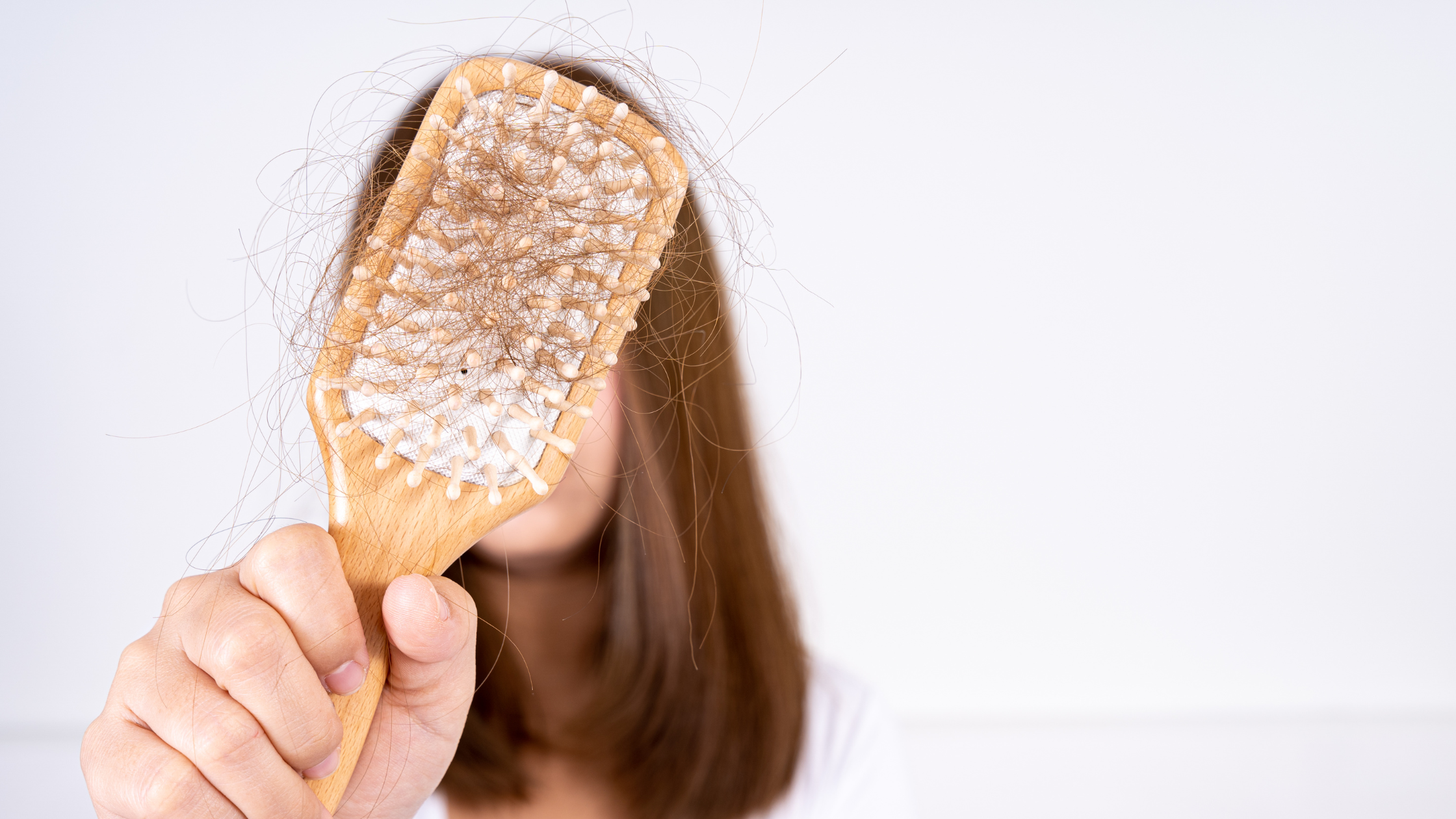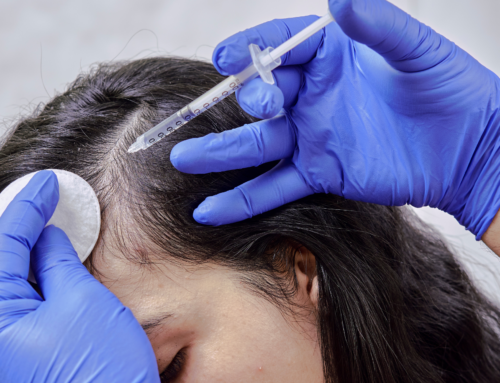The top 5 causes of hair loss are, thank goodness, generally things that you can control. Still, when hair loss happens to you, it’s… scary.
Hair loss doesn’t just affect your appearance; it can ruin your self-esteem and affect all of your relationships. It can feel like you’ve lost control of your body, and make you want to crawl under a rock and hide!
Friends, family, and, unfortunately, medical professionals will tell you not to worry, that things aren’t so bad, but hair loss is no joke. I see patients every day at Cellustrious® Hair Rejuvenation who are dealing with hair loss and believe me, it’s a very big deal to them.
Understanding the root causes of hair loss is the first step in reversing the loss and in the prevention and management of further loss. In this article, I’m going to delve into the biggest factors that contribute to hair loss – from hereditary influences to hormonal conditions – and what I consider the top 5 causes of hair loss.
1. Heredity and Genetics
Heredity and genetics play a large part in hair loss.
The hereditary condition known as androgenetic alopecia (AGA), is the most common cause of hair loss, and it affects both men and women. Our genes play a large role in our hair growth patterns. So, if your parents or experienced hair loss, there’s a higher likelihood that you might too. Understanding your family history can help you anticipate and address potential hair loss issues.
Ongoing research into hereditary hair loss shows the connection to genetics, yet the exact mechanisms aren’t greatly understood. While it’s true that genetic markers have been associated with androgenetic alopecia (genetic pattern hair loss) scientists are still trying to pinpoint exactly which genes are responsible for the predisposition.
One study, conducted in 2008 at the University of Bonn, Germany, showed that a variant on chromosome 20 — one of the 23 pairs of chromosomes you have — greatly increases your risk of male or female pattern baldness. Scientists still don’t know exactly what DNA is involved, but they do know that bald people tend to have a certain version of chromosome 20p11.
However, even if you’ve been diagnosed with AGA, don’t throw in the towel. There is some exciting new epigenetic research I’d like to share with you, and it can help in understanding how to manage loss associated with heredity and genetics.
The Role of Epigenetics
Researchers are investigating how certain epigenetic changes may be connected with hair loss – especially androgenetic alopecia.
Epigenetics is the study of how your behaviors and environment can cause changes that affect the way your genes work. Unlike genetic changes, epigenetic changes are reversible and do not change your DNA sequences, but they can change how your body reads a DNA sequence. These changes can influence the gene expression related to hair follicle activity.
Lifestyle issues, things like diet and stress, or environmental exposure to pollutants can affect epigenetic modifications related to hair. Researchers are developing tools to identify the epigenetic markers in people with hair loss to stop its progression – including changes that contribute to hair loss associated with aging.
Studying the epigenetic modifications that occur in hair follicles is key to developing new, alternative treatments. By making moderate changes, we can slow down, and reverse the damage done by our environment, diet, and lifestyle, and regain healthy hair at any age.
Epigenetics has the opportunity to revolutionize the way trichologists and medical professionals diagnose and treat hair loss caused by heredity and genetics.
2. Hormonal changes
Hormonal changes impact so many physiological processes in our bodies, and hair growth is just one of them.
Hormones act as messengers in the hair growth cycle, and if they are imbalanced, our hair will be impacted. One of the main hormones associated with hair loss is “dihydrotestosterone” (DHT), which is a byproduct of testosterone.
In men and women who are genetically predisposed to androgenetic alopecia (AGA), DHT binds to receptors at the base of the hair follicle under the scalp. If the DHT continues to bind to the follicles, they will shrink and the lifespan of the hair follicle will be shortened. This is known as “miniaturization,” and it causes the hair to become finer and weaker over time, eventually causing hair loss.
Estrogen, Progesterone and Hair Growth:
Hormones like estrogen and progesterone have a role in counteracting the effects of androgens and promoting a healthy hair growth cycle. Until they are disrupted by fluctuations, like in pregnancy, childbirth, and menopause.
During pregnancy, elevated estrogen and progesterone levels create a perfect environment for lush hair growth – AKA, the “pregnancy glow.” However, the postpartum period is followed by a marked decline in those hormones and can lead to hair loss, with a temporary increase in hair shedding. This usually happens three to six months after giving birth.
During menopause, a natural phase in a woman’s life, the decline in estrogen and progesterone production, combined with increased androgen levels, can result in thinning and hair loss. Menopausal hair changes are quite common.
While most of these changes are temporary, you may want to seek professional advice. It’s important to maintain overall health, and that will effect the condition of your hair during hormonal changes.
3. Cortisol and Stress-Induced Hair Loss:
Cortisol and stress-induced hair loss have become more common in our fast-paced world. We may not even realize we’re stressed, but when cortisol the “stress hormone,” is chronically elevated, it can lead to hair loss. Cortisol is important for many bodily functions, from metabolism to immune response. But when that stress is prolonged and cortisol levels continue to be produced by the adrenal glands, it has profound effects.
Chronic stress will disrupt the hair cycle and can lead to telogen effluvium (TE), which occurs when a large number of hair follicles are prematurely forced into the “resting phase,” by cortisol, which is acting as a disruptor. The result is shedding and poor hair density.
Elevated cortisol levels have also been shown to affect gene expression related to hair follicle regulation, so stress management is very important in managing cortisol. Regular exercise, relaxation/meditation, and adequate sleep are great ways to lower cortisol levels.
A holistic approach that manages external stressors and internal hormonal imbalances, combined with a healthy mindset, contributes to reversing cortisol and stress-related hair loss.
4 . Medical conditions
Medical conditions are often underlying a hair loss issue, and they must be addressed by a professional before dealing with the hair loss. If they are not addressed, the hair loss may not be resolved. Often, the process begins with a CBC or full blood count to measure individual components of your blood, including red blood cells, white blood cells, and platelets. This can indicate signs of inflammation around the hair follicles, signaling conditions that might be causing hair loss.
Auto-Immune Disorders:
Research suggests that genes along with certain autoimmune responses, increase the likelihood of alopecia areata, which occurs when the immune system mistakenly identifies hair follicles as threats by the immune system.
This perceived “threat” triggers an inflammatory response that stops normal hair development.
This immune-mediated “assault” occurs selectively. This condition can appear anywhere on the body, but on the scalp, it presents as random, patchy bald spots. Its appearance is much different than other types of hair loss.
Thyroid Hormones and Hair Health:
The thyroid, a small butterfly-shaped gland in the neck, is critical to regulating various physiological processes, including the hair growth cycle. Both hypothyroidism and hyperthyroidism, conditions stemming from an imbalance in thyroid hormone levels, exert distinct effects on the hair follicles, disrupting the normal progression of the hair growth cycle.
Hypothyroidism and Hair Health:
Hypothyroidism, or “underactive” thyroid, is an insufficient production of thyroid hormones, thyroxine (T4) and triiodothyronine (T3). These hormones are essential for maintaining the metabolic activities of cells.
In hypothyroidism, the decreased availability of thyroid hormones can lead to a cascade of effects on the hair. Hypothyroidism results when the hair growth cycle is disrupted, and a higher percentage of follicles enter the resting phase (telogen) prematurely. This disruption can change the texture of your hair, making it prone to breakage.
Hyperthyroidism and Excessive Hair Shedding:
Hyperthyroidism, or “overactive” thyroid gland, is an excess production of thyroid hormones. This heightened activity accelerates metabolic processes, and the hair growth cycle is accelerated, with more follicles entering the telogen (resting) phase simultaneously, leading to noticeable hair thinning, a diffuse reduction in density due to the shorter growth phase (anagen) of the hair follicles.
The Role of Thyroid Hormones in Hair Growth:
Thyroid hormones, T4 and T3, regulate cellular metabolism in your hair follicles. Imbalances in these hormone levels disrupt the duration and quality of each phase in the hair growth cycle.
Research has demonstrated the correlation between thyroid hormone levels and the expression of genes involved in hair follicle regulation.
Anemia and Nutritional Deficiencies:
Anemia, characterized by a deficiency of red blood cells or “hemoglobin,” extends its impact beyond overall health to influence hair health. Iron is key to synthesizing hemoglobin—the molecule responsible for carrying oxygen in red blood cells—and is crucial for the proper oxygenation of various tissues. Adequate oxygenation is necessary for hair growth and maintenance.
As anemia takes hold and iron levels decrease, it disrupts the normal phases of the hair follicle, resulting in a prolonged resting phase (telogen) and a shortened growth phase (anagen). The hair follicles linger in a dormant state for an extended period, leading to a reduction in actively growing hairs.
Anemia-related loss presents as visible signs of thinning and hair shedding.
Iron levels, hemoglobin synthesis, and the oxygenation of tissues are required for maintaining healthy hair follicles. Addressing iron-deficiency anemia requires replenishing iron levels to manage hair loss.
Polycystic Ovary Syndrome (PCOS):
PCOS, a common hormonal disorder among women, is associated with elevated androgen levels, primarily testosterone and dihydrotestosterone (DHT), and is characterized by reproductive, metabolic, and dermatological issues.
PCOS involves an imbalance in sex hormones, marked by an excess of androgens. Androgens, often considered “male” hormones, are present in both men and women but in different proportions. It’s these elevated androgen levels in women with PCOS that disrupt the hormonal equilibrium.
The mechanism behind androgen-induced hair loss has to do with the hair follicles’ sensitivity to certain androgens. These androgens may bind to specific receptors in the scalp, leading to miniaturization of the hair follicles. This miniaturization creates finer, shorter hair strands and eventually leads to visible thinning.
Trichologists, endocrinologists, and dermatologists play roles in assessing the hormonal profile of women with PCOS. Together, they can develop custom-tailored treatment protocols to address the challenges caused by androgen-induced hair thinning.
Autoimmune Diseases: Rheumatoid Arthritis and Lupus
Autoimmune diseases, such as rheumatoid arthritis and lupus, have a profound influence on the body beyond just the joints and organs. These systemic conditions can cause the immune system, whose job is to defend against invaders, to go “rogue.” When this occurs, the body mistakenly sees its own -tissues as a “threat.”
If the autoimmune system launches an attack on the hair follicles, it triggers an inflammatory response, disrupting the normal functioning of hair follicles. This cycle of disruption leads to a shutdown of the growth phase, resulting in poor hair quality and loss.
Managing autoimmune-related hair loss is tricky because it usually requires a multidisciplinary approach. Not only do we need to deal with the autoimmune condition as it affects the hair, we have to consider the broader context of each person’s health.
Immunosuppressive medications are often prescribed to modulate the hyperactive immune system to slow down the inflammatory response and help reduce the severity of hair loss.
Because the body is complex, and the hair follicles are what we call “inefficient” mini-organs, they are very sensitive. It’s important to get professional support, especially if you have any known medical conditions.
5. Hairstyles and treatments
The choices you make in styling and treating your hair can have a major influence on the health and quality of your hair follicles, hair shaft, and scalp.
Traction Alopecia and Hairstyles:
Traction alopecia is caused by prolonged tension or pulling on the hair. Tight braids, ponytails, or extensions, cause stress on the hair shaft and follicles. Over time, tension can lead to weakened hair strands, breakage, and even scarring of the hair follicles, to the point of death.
Chemical Treatments and Hair Damage:
Perming, relaxing, coloring, and harsh chemicals can damage the structural integrity of the hair. They can strip the hair of its natural oils, leaving you with dry, brittle hair. Chemical damage can affect the scalp and the health of hair follicles.
Heat Styling and Thermal Damage:
Thermal damage is caused by the excessive use of heat-styling tools like flat irons, curling irons, and blow dryers, which can cause thermal damage to the hair shaft. Applying high heat to the hair can strip it of moisture, making it prone to dryness, frizz, and breakage. To prevent thermal damage, always use heat styling tools on the lowest or “cool” setting when possible and use heat-protectants in your hair whenever possible.
Hair Care Practices:
Neglecting proper hair care can contribute to hair loss. Infrequent washing and inadequate hydration can impact the health of the hair and scalp. Establish a regular hair care routine that includes gentle, non-toxic (sulfate and paraben-free) cleansing, conditioning, and nourishment. These are all essential for maintaining your hair and keeping it healthy.
Thinning Hair Treatments:
Some off-the-shelf and prescribed hair growth treatments and products can have adverse side effects. It’s really important to choose your hair loss treatments carefully and do your research.
Before committing to a treatment, consider things like the underlying cause of your hair loss, the potential side effects of a treatment, and your suitability. Always test products first to see if you have reactions, such as stinging, burning, or body-related discomfort. If so, find an alternative solution.
Personalized Treatment Approaches:
Personalized treatment approaches are necessary because no matter what caused your hair thinning or loss, you need a customized plan of action to resolve it. You have a unique profile and microbiome, which needs to be addressed before determining what steps to take. A complete plan that includes an investigation of the causes, including a hair analysis and trichoscopic exam, a proven method of treatment that addresses the underlying causes, and a plan for improving the treatment plan when needed.
Cellustrious® uses epigenetic-based research to create holistic, natural hair loss treatment protocols that target specific molecular pathways and internal issues tied to hair loss. This approach is the most effective way I’ve seen to reverse the Top 5 Things Cause of hair loss.
If you are experiencing hair loss, seek professional advice. Schedule a telehealth consultation with Misti Barnes, our expert trichologist, to address your concerns and explore telehealth solutions. Alternatively, if you’re located in the Sarasota or Bradenton area, feel free to contact us for an in-person office consultation at (941) 909-7701.
Your hair and health matter. We’re here to help you find the best solutions.





